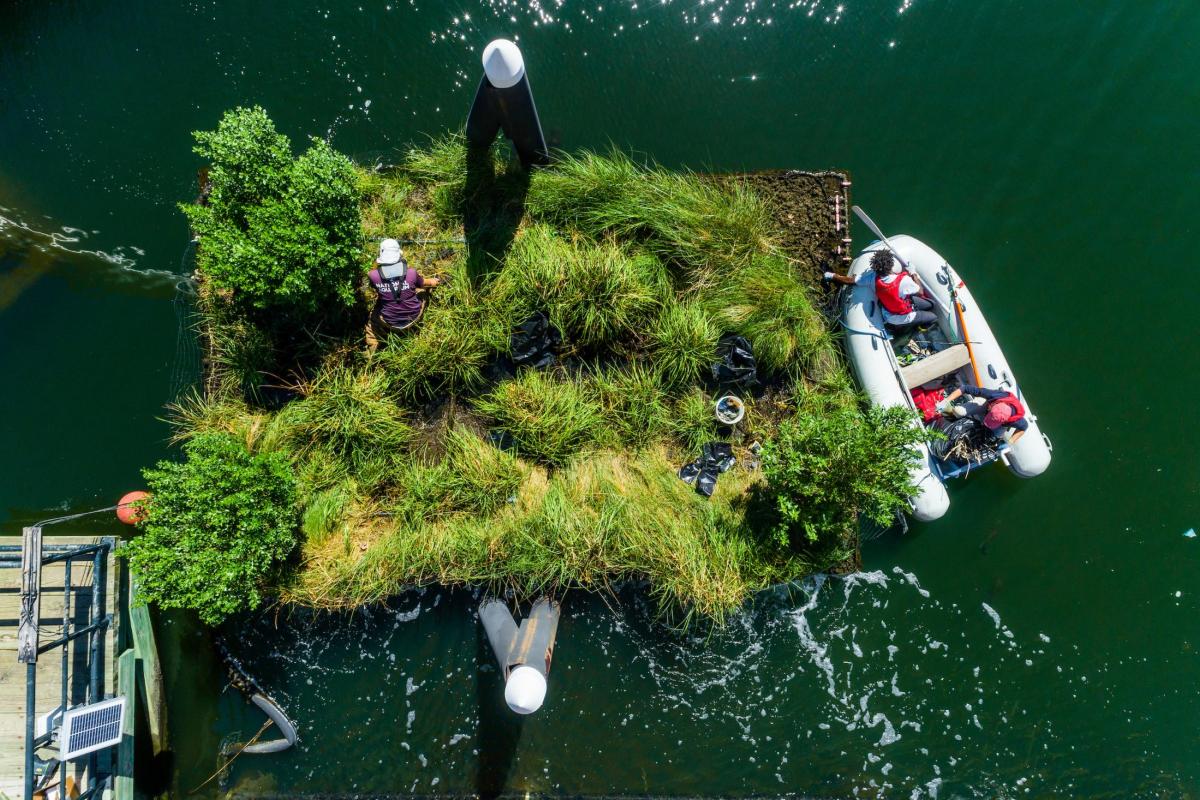
As the weather warms up and Baltimore thaws out, crowds will no doubt begin to gather at the Inner Harbor. Someone who’s gone a while without visiting—or never paid that much attention—might be, at first, thrown off by a patch or two of ground floating in the water between piers 3 and 4.
Those floating patches of land are working prototypes and the latest iteration of the National Aquarium’s floating wetlands project, which the aquarium has been working on for more than a decade.
“It’s a technology to reintroduce a shallow water habitat [in the city]” and improve the harbor’s ecological health, says Charmaine Dahlenburg, director of field conservation at the National Aquarium. “That’s the simplest, short answer.”
Prototype technology
The aquarium’s first floating wetland, which was put in place in 2010, “faced overuse from Canada geese,” according to the organization, among other issues. A second version, from around the same time, faced similar problems.
A third floating wetland, being used in the harbor today, was installed in 2015 and is still being studied for its effectiveness. The newest floating wetland, at around 400 square feet, was a custom-built prototype installed in 2017. It has four components that were designed based on previous visions of the floating wetlands, according to the National Aquarium: elevation changes to allow for different kinds of shrubs and grasses, a center channel with moving water, an aeration system, and a structure built to withstand the harsh, brackish conditions of the Inner Harbor.
Someone looking at the floating wetland this time of year might think it looks a bit dead, but it’s merely coming out of dormancy.
“It’s going to turn very, very lush and green,” Dahlenburg says. “That’s when the birds start to come in. There are some insects, there might be a snake, and definitely a lot of fish around it.”
What’s the point?
By studying how the prototype floating wetlands function in the harbor—and what effects they have on the water around it—the National Aquarium can prepare for a more ambitious project, Dahlenburg explains.
The current wetlands aren’t big enough to have a “huge” effect on the overall health of the harbor, Dahlenburg says, as it’s just “one small piece” of the harbor. They allow aquarium staff and other researchers to gain an understanding of how different factors, like the presence of marsh grasses, for example, can impact water quality. But, the aquarium does have plans to construct a larger floating wetland that will measure up to 15,000 square feet. Those plans, which would place the wetland in between the same piers as the current prototype, include docks that would allow guests to get a closer look.
Dahlenburg says that could be a big step in reintroducing a shallow water habitat to parts of the harbor.
“Baltimore looked a lot different 200 years ago,” she says. “In an urban setting like Baltimore City, we have a lot of [infrastructure] that will never be removed. The harbor is what it is. We have to find a way to introduce that shallow water habitat to cleanse the water.”
The bigger picture
Matthew Baker, a professor of geography and environmental systems at the University of Maryland, Baltimore County, says the floating wetlands do a great job of introducing visitors—especially young visitors—to concepts around water quality and ecological restoration.
The floating wetlands, and other restoration projects (like Mr. Trash Wheel, for example), help raise awareness on how the general public contributes to pollution and water quality, and demonstrate novel ideas for how to clean the water up, he says.
“Asking me whether it’s effective, I’m not sure what the expectations are,” he says. “[But] if it calls attention to how incredible natural wetlands are, and how great a service they provide, then I think this kind of thing is effective and a success.”
